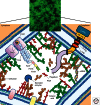Bacterial biofilms: development, dispersal, and therapeutic strategies in the dawn of the postantibiotic era
- PMID: 23545571
- PMCID: PMC3683961
- DOI: 10.1101/cshperspect.a010306
Bacterial biofilms: development, dispersal, and therapeutic strategies in the dawn of the postantibiotic era
Abstract
Biofilm formation constitutes an alternative lifestyle in which microorganisms adopt a multicellular behavior that facilitates and/or prolongs survival in diverse environmental niches. Biofilms form on biotic and abiotic surfaces both in the environment and in the healthcare setting. In hospital wards, the formation of biofilms on vents and medical equipment enables pathogens to persist as reservoirs that can readily spread to patients. Inside the host, biofilms allow pathogens to subvert innate immune defenses and are thus associated with long-term persistence. Here we provide a general review of the steps leading to biofilm formation on surfaces and within eukaryotic cells, highlighting several medically important pathogens, and discuss recent advances on novel strategies aimed at biofilm prevention and/or dissolution.
Figures



References
-
- Allaker RP 2010. The use of nanoparticles to control oral biofilm formation. J Dent Res 89: 1175–1186 - PubMed
-
- Anderson GG, Palermo JJ, Schilling JD, Roth R, Heuser J, Hultgren SJ 2003. Intracellular bacterial biofilm-like pods in urinary tract infections. Science 301: 105–107 - PubMed
-
- Anderson GG, Martin SM, Hultgren SJ 2004. Host subversion by formation of intracellular bacterial communities in the urinary tract. Microbes Infect 6: 1094–1101 - PubMed
-
- Allesen-Holm M, Barken KB, Yang L, Klausen M, Webb JS, Kjelleberg S, Molin S, Givskov M, Tolker-Nielsen T 2006. A characterization of DNA release in Pseudomonas aeruginosa cultures and biofilms. Mol Microbiol 59: 1114–1128 - PubMed
Publication types
MeSH terms
Substances
Grants and funding
- R37 AI048689/AI/NIAID NIH HHS/United States
- R01 AI029549/AI/NIAID NIH HHS/United States
- R01 AI048689/AI/NIAID NIH HHS/United States
- R01 AI049950/AI/NIAID NIH HHS/United States
- P50 DK064540/DK/NIDDK NIH HHS/United States
- R01 AI099099/AI/NIAID NIH HHS/United States
- U54 AI057160/AI/NIAID NIH HHS/United States
- P41 RR000954/RR/NCRR NIH HHS/United States
- R01 AT002058/AT/NCCIH NIH HHS/United States
- RC1 DK086378/DK/NIDDK NIH HHS/United States
- R37 AI029549/AI/NIAID NIH HHS/United States
- R01 DK051406/DK/NIDDK NIH HHS/United States
LinkOut - more resources
Full Text Sources
Other Literature Sources
Medical
